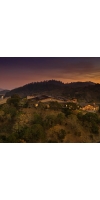Wine from Silverado Vineyards

In 1981, Ron and Diane Miller and her mother, Lillian Disney, established Silverado Vineyards to make wines from the historic sites of their estate. For years, they had sold their fruit to neighboring wineries who were building global reputations for excellence. It was time, they decided, to create their own wines, their own expressions of the Napa Valley they loved and admired.
The winery takes its name from the historic vineyard which surrounds it. The vineyard borrowed its name from the abandoned mining town at the top of the Napa Valley. Here, over a century ago Robert Louis Stevenson stayed and wrote, “The beginning of vine planting is like the beginning of mining for precious metals: the winegrower also ‘prospects’.” Four generations of Millers are still ‘prospecting’ for wine, making something beautiful from the land under their care.
A gem in the heart of Stags Leap District, Silverado Vineyards has embarked on its fourth decade of producing estate-grown, produced, and bottled fine wines. The third and fourth generations of the Miller family continue the founders' legacy.
Silverado Vineyard was one of the first four in Stags Leap District to plant Cabernet in the 1960s. The winery owns five other storied vineyards across Napa Valley’s top AVAs: Miller Ranch in Yountville, Mt. George in Coombsville, Soda Creek/Borreo Ranch, and both Firetree and Vineburg in Carneros. The estate is comprised of over 600 acres. Forty percent of the land is preserved, and 360 acres are sustainably farmed and certified Napa Green.
Winemaker Jon Emmerich is tasked with evoking a sense of place in the estate wines produced from these contrasting and historic vineyard sites. In 2020, Jon celebrated his 30th anniversary with the winery, and his counterpart, associate winemaker Elena Franceschi celebrated her 25th anniversary. Together, they have grown Silverado Vineyards’ reputation for quality and consistency.
No products found
- back
Selected Options
Wineries
Categories
Pricing
Countries
Regions
Grape Types
Wineries
Organic/Free Shipping
Force Majeure Epinette is made from 79% Merlot, 8% Cabernet Sauvignon, 8% Cabernet Franc, and 5% Petit Verdot .
Epinette is Force Majeure's Right-bank Bordeaux-inspired blend, and was named after an avenue in Libourne (France) that leads to Pomerol and Saint-Émilion, the home of Merlot and Cabernet Franc. Epinette is also the name of a musical instrument akin to a piano, as well as a word for pine tree, which is a fitting nod to their home in Washington state.
The wine itself is a blend of primarily Merlot and Cabernet Franc, with smaller amounts of Cabernet Sauvignon and Petit Verdot, proportions of which change depending on the vintage. The Merlot and Cabernet Franc are grown in lower areas of the vineyard with deep, well-drained soils, much less rocky than the soils of our Rhone varietals.
Review:
The 2018 Epinette is the Merlot-dominated release from this team, and it's 79% Merlot, 8% Cabernet Sauvignon, 8% Cabernet Franc, and 5% Petit Verdot, all from the estate vineyard on Red Mountain. Lots of smoky black cherry and darker currant fruits as well as notes of chocolate, graphite, lead pencil, and chalky minerality emerge from the glass, and this full-bodied beauty is beautifully textured, with a stacked mid-palate, velvety tannins, and a blockbuster finish. It's up with the finest Merlots in the New World and will drink brilliantly for at least a decade, if not longer.
Previously known as Grand Reve, Force Majeure has skyrocketed to the top of the pyramid in Washington State, in no small part due to their talented winemaker, Todd Alexander, who moved from Bryant Family in Napa to Washington State to focus on this estate. While the focus is on their Red Mountain Vineyard, they make a bevy of world-class wines from throughout the Columbia Valley. Anyone doubting the quality coming from Washington State these days owes it to themselves to try these wines.
-Jeb Dunnuck 97 Points
Long Shadows Poets Leap Riesling is made from 100 percent Riesling.
Tasting Notes: The Poet's Leap Riesling offers aromas of white peach, jasmine, Thai basil and nutmeg. Flavors of ripe melon, apricot and an appealing minerality continue across the palate. An underlying hint of honey sweetness is balanced by a streak of bright acidity that provides a long, clean finish.




